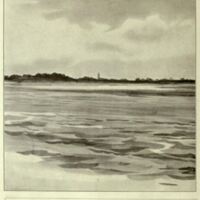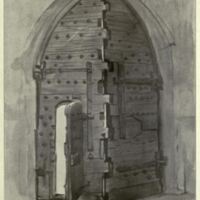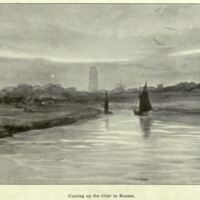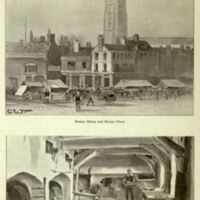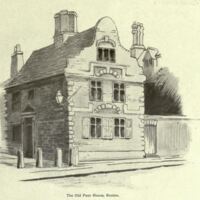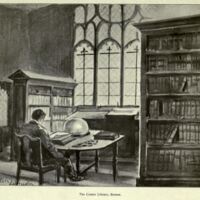Description
By the early twentieth century Boston, Lincolnshire had become an important point of interest on the Mayflower tourist trail. Its association with the group later known as the Pilgrim Fathers stretches back to 1607 when the small band of men, women and children met in secret on the edge of 'The Wash' at Scotia Creek, Fishtoft, near the town. Disobeying the authority of the Anglican church they planned to escape across the North Sea to Holland. However, the group were ultimately betrayed, brought to Boston, then held as prisoners at the Guildhall.
To tell the exciting story of thwarted escape and betrayal Mackennel cites theologian, historian, and pastor John Brown (1830–1922) and his 1895 work The Pilgrim Fathers of New England. The use of Brown shows that Mackennal is conscious of British Mayflower history writing which had become well established over the nineteenth century. Whymper provides several watercolour insulations of Boston’s landmarks including St Botolph's Church informally known as 'Boston Stump'.
“The associations of Boston in Lincolnshire with the Pilgrim Fathers are twofold. In the early part of the seventeenth century that growing port on the Witham was the scene of the first attempt on the part of the members of the Church at Scrooby to escape to Holland. The little sleepy English town, on the other hand, added more than it deemed to its own glory when it gave the name of Boston to that settlement on the eastern shores of Massachusetts which rapidly developed into the great town which has had so much to do, during the last century and a half, with the history and development of the United States. But the English Boston was not linked by any such close and intimate association with the origin and fortunes of the Pilgrim Fathers as Gainsborough and Scrooby and Standish.
Although the history of Boston, like that of many another quiet English town, stretches back into a remote past, and although ever since the Norman Conquest it has been the seat of commercial activity and of steadily increasing trade, especially as a port on the east coast, yet for the great majority of Englishmen 'Boston Stump' sums up their knowledge of the antiquities and features of interest in the town.
[…]
Under a king like James I., and with Bishops like Laud and Bancroft not only in power, but supported by the whole authority of king and executive, the humble Christians of Gainsborough and Scrooby were certain to fare but ill. So intolerable did their position become, that they determined to take refuge in the only European country where religious toleration was possible in Holland. But whilst it meant fines, imprisonment, and possibly death to stay, escape was illegal, and had to be accomplished secretly. It is here that Boston be- comes prominent in our story. What happened there cannot be better told than in the words of Dr. John Brown.
'These voyagers in search of freedom resolved to move as a body, and not in detached companies, and to make Boston, on the Lincolnshire coast, their point of departure. They therefore hired a vessel wholly to themselves, making agreement with the captain to be ready at a certain date to take them and their goods at a convenient place where they would meet him. Meantime the deceitful scoundrel had privately arranged their betrayal, and no sooner had they stepped on board than the officers and searchers were at hand to arrest them. Put back into open boats, the minions of the law "rifled and ransacked them, searching them to their shirts for money, yea, even the women further than became modesty, and then carried them back into the town, and made them a spectacle and a wonder to the multitude who came flocking on all sides to behold them. Being thus first by the catchpole officers rifled and stripped of their money, books, and much other goods, they were presented to the magistrates, and messengers were sent to inform the Lords of the Council of them ; and so they were committed to ward."
'Boston, in which these unfortunate prisoners found themselves after their arrest, one of the most curious old towns in England, had long been declining from the good old days when, in the reign of Edward III., it sent seventeen ships and three hundred and sixty men for the invasion of Brittany. Its ancient buildings,- the quaint old house in Wormgate, the old building in Spain Lane, the Grammar School, the Hussey Tower, the Guildhall in South Street, and, most of all, the great Church of St. Botolph, with its magnificent tower, seen as a landmark far off at sea, and known all the world over as Boston Stump, these all bespeak the antiquity and former importance of this eastern port on the Lincolnshire coast. It was in the old court-room on the first floor of the Guildhall that William Brewster and his companions were presented to the magistrates, and it was to the old cells, still to be seen on the ground floor, they were remitted back " till order came from the Council Table." These cells had been in use at that time for about sixty years, for "in 1552 it was ordered that the kitchen under the town-hall and the chambers over them should be prepared for a prison and a dwelling-house for one of the sergeants."

